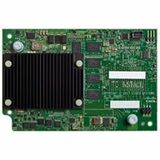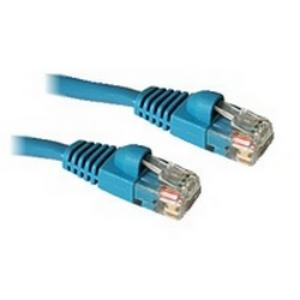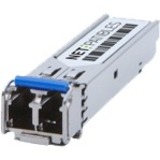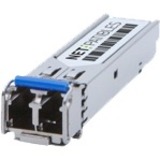Cisco 1480 Interface Module - For Server, Data Networking, Optical NetworkOptical Fiber40 Gigabit Ethernet - 40GBase-X - 2.0 x Expansion Slots - SFP28 - Plug-in Module UCSB-VIC-M84-4P=
UCSB-VIC-M84-4P= | Cisco®
Part Number: UCSB-VIC-M84-4P=
Condition: New
In Stock: 7
Real time availability 
Product Specifications
Cisco 1480 Interface Module - For Server, Data Networking, Optical NetworkOptical Fiber40 Gigabit Ethernet - 40GBase-X - 2.0 x Expansion Slots - SFP28 - Plug-in Module UCSB-VIC-M84-4P=
UCS VIC 1480 MEZZ FOR B-SERIES BOPT -
Manufacturer Part Number: UCSB-VIC-M84-4P=
FACTORY DIRECT ONLY - Cisco UCS VIC 1480 MEZZ for B-Series
MANUFACTURER NAME: Cisco
MANUFACTURER PART NUMBER: UCSB-VIC-M84-4P=
UPC EAN CODE: 889728010214
LANGUAGE: EN
MARKET:US
| General Information: | |
Cisco Unified Computing System overview The Cisco Unified Computing System (Cisco UCS) is a next-generation data center platform that unites computing, networking, storage access, and virtualization resources in a cohesive system designed to reduce Total Cost of Ownership (TCO) and increase business agility. The system integrates a low-latency, lossless 10/25/40/100 Gigabit Ethernet network fabric with enterprise-class blade and rack x86-architecture servers. The system is an integrated, scalable, multi-chassis platform in which all resources participate in a unified management domain. Portfolio overview The Cisco UCS Virtual Interface Card (VIC) 1400/14000 Series (Figure 1) extends the network fabric directly to both servers and virtual machines so that a single connectivity mechanism can be used to connect both physical and virtual servers with the same level of visibility and control. Cisco VICs provide complete programmability of the Cisco UCS I/O infrastructure, with the number and type of I/O interfaces configurable on demand with a zero-touch model Cisco VICs support Cisco SingleConnect technology, which provides an easy, intelligent, and efficient way to connect and manage computing in your data center. Cisco SingleConnect unifies LAN, SAN, and systems management into one simplified link for rack servers, blade servers, and virtual machines. This technology reduces the number of network adapters, cables, and switches needed and radically simplifies the network, reducing complexity. Cisco VICs can support 256 Express (PCIe) virtual devices, either virtual Network Interface Cards (vNICs) or virtual Host Bus Adapters (vHBAs), with a high rate of I/O Operations Per Second (IOPS), support for lossless Ethernet, and 10/25/40/100-Gbps connection to servers. The PCIe Generation 3 x16 interface helps ensure optimal bandwidth to the host for network-intensive applications, with a redundant path to the fabric interconnect. Cisco VICs support NIC teaming with fabric failover for increased reliability and availability. In addition, it provides a policy-based, stateless, agile server infrastructure for your data center. The VIC 1400/14000 series is designed for UCS X-Series M6 Blade Servers, B-Series M5 and M6 Blade Servers, C-Series M5 and M6 Rack Servers, and S-Series M5 Storage Servers. The adapters are capable of supporting 10/25/40/100-Gigabit Ethernet and Fibre Channel over Ethernet (FCoE). It incorporates Cisco's next-generation Converged Network Adapter (CNA) technology and offers a comprehensive feature set, providing investment protection for future feature software releases. In addition, the VIC supports Cisco's Data Center Virtual Machine Fabric Extender (VM-FEX) technology. This technology extends the Cisco UCS fabric interconnect ports to virtual machines, simplifying server virtualization deployment. | |
| Manufacturer | Cisco Systems, Inc |
| Manufacturer Part Number | UCSBVICM844P |
| Manufacturer Website Address | http://www.cisco.com |
| Brand Name | Cisco |
| Product Series | 1400 |
| Product Model | 1480 |
| Product Name | 1480 Interface Module |
| Product Type | Interface Module |
| Product UPC | 889728010214 |
| Technical Information: | |
| Application/Usage | Server
Data Networking Optical Network |
| Media & Performance: | |
| Media Type Supported | Optical Fiber |
| Ethernet Technology | 40 Gigabit Ethernet |
| Network Technology | 40GBase-X |
| I/O Expansions: | |
| Total Number of Expansion Slots | 2.0 |
| Expansion Slot Type | SFP28 |
| Physical Characteristics: | |
| Form Factor | Plug-in Module |
| Height | 1.3" |
| Width | 2.9" |
| Miscellaneous: | |
| Compatibility | Cisco Servers:
|
| Country of Origin | China |
Questions and Answers
Questions and Answers | Ask CompSource |
Shipping / Returns
Shipping
Ground =
FREE
(EST. Arrival Date between
Wed.Nov.13 - Mon.Nov.18)
Two Day Air = $26.00
(EST. Arrival Date on Wed.Nov.13)
Standard One Day = $38.00
(EST. Arrival Date on Tue.Nov.12 after 3PM)
Priority = $55.00
(EST. arrival Date on Tue.Nov.12 in the AM)
U.S Mail Priority (AA,AE,AP only) = $32.00
FedEx International Economy (Canada only) = $86.00
Shipping dates are best estimates based on product location and may vary with holidays.
If product requires trucking, additional fees may apply.
* Some destinations are subject to Applicable State/Duty Taxes
Returns
CompSource realizes that every product may have different return guidelines. Please see the policy below regarding this item.
This Product Has Limited Exchange Privileges.
Please call for return guidelines.
For support on this product, please contact Cisco. 800-553-6387 www.cisco.com
Cisco Company's Information
Click Cisco for all products
Local #: (408)526-4000
Toll Free #: 800-553-6387
Tech Support #: 800-553-2447
Site: www.cisco.com
Product Reviews
Overall Rating | Write a Review
|
|
Best Sellers
More Best Sellers
Rebates
More Rebates
About Cisco
Cisco's approach to quality can be condensed down to one phrase: "ensuring our customer success". The information contained in this section will help you to gain a better understanding of Cisco's Business Management System, which allows us to accomplish that success. Cisco's Business Management System is made up of two parts; the Quality Management System and the Environmental Management System.
Cisco Fun Facts
Cisco Systems, Inc. is an American multinational technology conglomerate headquartered in San Jose, California, in the center of Silicon Valley, that develops, manufactures and sells networking hardware, telecommunications equipment and other high-technology services and products. Through its numerous acquired subsidiaries, such as OpenDNS, WebEx, Jabber and Jasper, Cisco specializes into specific tech markets, such as Internet of Things (IoT), domain security and energy management.
Cisco is the largest networking company in the world. The stock was added to the Dow Jones Industrial Average on June 8, 2009, and is also included in the S&P 500 Index, the Russell 1000 Index, NASDAQ-100 Index and the Russell 1000 Growth Stock Index.
Cisco Systems was founded in December 1984 by Leonard Bosack and Sandy Lerner, two Stanford University computer scientists, who pioneered the concept of a local area network (LAN) being used to connect geographically disparate computers over a multiprotocol router system. By the time the company went public in 1990, when it was listed on the NASDAQ, Cisco had a market capitalization of $224 million. Cisco was the most valuable company in the world by 2000, with a more than $500 billion market capitalization
Here are some great product categories from Cisco;
Learn more about Switch Modules
Switches, routers, and wireless access points
Switches, routers, and wireless access points perform very different functions in a network.
A computer network, or data network, is a digital telecommunications network which allows nodes to share resources. In computer networks, computing devices exchange data with each other using connections (data links) between nodes These data links are established over cable media such as wires or optic cables, or wireless media such as WiFi.Switches
Switches are the foundation of most business networks. A switch acts as a controller, connecting computers, printers, and servers to a network in a building or a campus.
Switches allow devices on your network to communicate with each other, as well as with other networks, creating a network of shared resources. Through information sharing and resource allocation, switches save money and increase productivity.
There are two basic types of switches to choose from as part of your networking basics: managed and unmanaged.
- An unmanaged switch works out of the box but can't be configured. Home-networking equipment typically offers unmanaged switches.
- A managed switch can be configured. You can monitor and adjust a managed switch locally or remotely, giving you greater control over network traffic and access.
Routers
Routers connect multiple networks together. They also connect computers on those networks to the Internet. Routers enable all networked computers to share a single Internet connection, which saves money.
A router acts a dispatcher. It analyzes data being sent across a network, chooses the best route for data to travel, and sends it on its way.
Routers connect your business to the world, protect information from security threats, and can even decide which computers receive priority over others.
Beyond those basic networking functions, routers come with additional features to make networking easier or more secure. Depending on your needs, for example, you can choose a router with a firewall, a virtual private network (VPN), or an Internet Protocol (IP) communications system.
Access points
An access point* allows devices to connect to the wireless network without cables. A wireless network makes it easy to bring new devices online and provides flexible support to mobile workers.
An access point acts like an amplifier for your network. While a router provides the bandwidth, an access point extends that bandwidth so that the network can support many devices, and those devices can access the network from farther away.
But an access point does more than simply extend Wi-Fi. It can also give useful data about the devices on the network, provide proactive security, and serve many other practical purposes.
*Access points support different IEEE standards. Each standard is an amendment that was ratified over time. The standards operate on varying frequencies, deliver different bandwidth, and support different numbers of channels.
Wireless networking
Wireless networking is a method by which homes, telecommunications networks and business installations avoid the costly process of introducing cables into a building, or as a connection between various equipment locations.CompSource will educate and help make this process enjoyable and easy.
Whether you're planning on using your network for basic home tasks or enterprise level security. You can tell our trained sales professionals your needs, and we'll make custom recommendations to suit your specifications and budget. Our reps have extensive knowledge and love to share. We educate, not sell, CompSource makes sure you buy what you need and not waste money on what you don't. As with every decision we never push, it's up to you when, and if you make a purchase.
CompSource has a great technical staff that can help with a solution for your exact needs.
Chat with us or give our professionals a quick phone call (800)-413-7361.
Great selection of products! Very competitive! Fast Shipping! Chris C.More Reviews






















